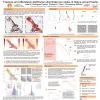Poster #158, Fault and Rupture Mechanics (FARM)
3D dynamic rupture modeling with thermal pressurization
Poster Image:

Poster Presentation
2020 SCEC Annual Meeting, Poster #158, SCEC Contribution #10698 VIEW PDF
and earthquake faults through thermal pressurization of pore fluids using an accurate spectral implementation (Noda & Lapusta, 2010) in the Discontinuous Galerkin software SeisSol. We show superior accuracy of this implementation with computationally comparable cost compared to combining SeisSol with a finite difference TP approach on supercomputing infrastructure.
We employ dynamic rupture modeling to examine the effects of hydraulic diffusivity and the half width of the shear zone on earthquake kinematic properties such as mean slip, peak slip rate and rupture speed, and synthetic ground motions. We statistically analyze a suite of 3D models under rate-and-state (strong velocity weakening) friction incorporating a shallow velocity-strengthening region in which also hydraulic diffusivity varies and smooth rupture arrests. We observe highly sensitive trade-offs of rupture nucleation, dynamic weakening effects, realistic heat production and fault stress and strength initial conditions. We then find that varying the half width of the shear zone within observational uncertainties impacts the resulting mean peak slip rate stronger than other TP parameters, whereas the effects of hydraulic diffusivity and shear zone width on rupture speed are comparably large. Additionally, the mean slip decreases with increasing hydraulic diffusivity, but remains nearly unaffected by variations of the half width of the shear zone.
SeisSol employs fully adaptive, unstructured tetrahedral meshes suitable to combine geometrically complex 3D geological structures, nonlinear rheologies, and high-order accurate propagation of seismic waves. Hence, future work will combine TP with geometric 3D fault complexity and analyze trade-offs with off-fault plasticity (Wollherr et al., 2019, Ulrich et al., 2019).
SHOW MORE
We employ dynamic rupture modeling to examine the effects of hydraulic diffusivity and the half width of the shear zone on earthquake kinematic properties such as mean slip, peak slip rate and rupture speed, and synthetic ground motions. We statistically analyze a suite of 3D models under rate-and-state (strong velocity weakening) friction incorporating a shallow velocity-strengthening region in which also hydraulic diffusivity varies and smooth rupture arrests. We observe highly sensitive trade-offs of rupture nucleation, dynamic weakening effects, realistic heat production and fault stress and strength initial conditions. We then find that varying the half width of the shear zone within observational uncertainties impacts the resulting mean peak slip rate stronger than other TP parameters, whereas the effects of hydraulic diffusivity and shear zone width on rupture speed are comparably large. Additionally, the mean slip decreases with increasing hydraulic diffusivity, but remains nearly unaffected by variations of the half width of the shear zone.
SeisSol employs fully adaptive, unstructured tetrahedral meshes suitable to combine geometrically complex 3D geological structures, nonlinear rheologies, and high-order accurate propagation of seismic waves. Hence, future work will combine TP with geometric 3D fault complexity and analyze trade-offs with off-fault plasticity (Wollherr et al., 2019, Ulrich et al., 2019).
SHOW MORE
























































